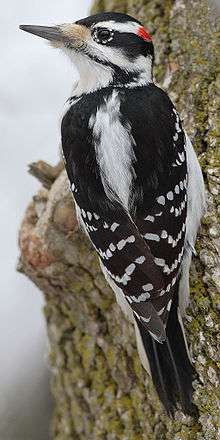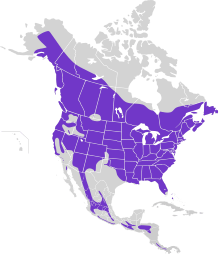Hairy woodpecker
The hairy woodpecker (Leuconotopicus villosus) is a medium-sized woodpecker that is found over a large area of North America. It is approximately 250 mm (9.8 in) in length with a 380 mm (15 in) wingspan.[2] With an estimated population in 2003 of over nine million individuals, the hairy woodpecker is listed by the IUCN as a species of least concern.[3] Some ornithologists place this species in the genus Dryobates.
| Hairy woodpecker | |
|---|---|
 | |
| Male, eastern subspecies septentrionalis | |
| Scientific classification | |
| Kingdom: | Animalia |
| Phylum: | Chordata |
| Class: | Aves |
| Order: | Piciformes |
| Family: | Picidae |
| Genus: | Leuconotopicus |
| Species: | L. villosus |
| Binomial name | |
| Leuconotopicus villosus (Linnaeus, 1766) | |
 | |
| Synonyms | |
| |
Taxonomy
The hairy woodpecker was described and illustrated with a hand-coloured plate by the English naturalist Mark Catesby in his The Natural History of Carolina, Florida and the Bahama Islands which was published between 1729 and 1732.[4] When in 1766 the Swedish naturalist Carl Linnaeus updated his Systema Naturae for the twelfth edition, he included the downy woodpecker, coined the binomial name Picus villosus and cited Catesby's book.[5] The specific epithet villosus is the Latin word for "hairy".[6] Linnaeus specified the type locality as America septentrionali (North America) but the locality is now restricted to Raccoon Creek (New Jersey).[7] The hairy woodpecker was formerly usually placed in either Dendrocopos or Picoides but a molecular phylogenetic study published in 2015 found that these genera did not form monophyletic groups.[8] In the revised generic classification, the hairy woodpecker was moved to the genus Leuconotopicus that was erected by the French ornithologist Alfred Malherbe in 1845.[9][10] Some taxonomic authorities place the hairy woodpecker in an expanded Dryobates that includes all the species in the genera Leuconotopicus and Veniliornis.[11][12]
Seventeen subspecies are recognised:[10]
- L. v. septentrionalis (Nuttall, 1840) – west North America from south Alaska to Ontario to New Mexico
- L. v. picoideus (Osgood, 1901) – Queen Charlotte Island (off British Columbia, Canada)
- L. v. harrisi (Audubon, 1838) – southeast Alaska to north California
- L. v. terraenovae (Batchelder, 1908) – Newfoundland
- L. v. villosus (Linnaeus, 1766) – southeast Canada, north central and northeast USA
- L. v. orius (Oberholser, 1911) – south central British Columbia to southeast California and southwest Utah
- L. v. monticola (Anthony, 1898) – central British Columbia to north New Mexico
- L. v. leucothorectis (Oberholser, 1911) – southeast California to west Texas
- L. v. audubonii (Swainson, 1832) – southeast USA
- L. v. hyloscopus (Cabanis & Heine, 1863) – west and south California, north Baja California (Mexico)
- L. v. icastus (Oberholser, 1911) – southeast Arizona, southwest New Mexico to west Mexico
- L. v. intermedius (Nelson, 1900) – east Mexico
- L. v. jardinii Malherbe, 1845 – south central and east central Mexico
- L. v. sanctorum (Nelson, 1897) – southeast Mexico to northwest Nicaragua
- L. v. extimus (Bangs, 1902) – north central Costa Rica to west Panama
- L. v. piger (Allen, GM, 1905) – north Bahamas
- L. v. maynardi (Ridgway, 1887) – south Bahamas
Description
.jpg)
Adults are mainly black on the upper parts and wings, with a white or pale back and white spotting on the wings; the throat and belly vary from white to sooty brown, depending on subspecies. There is a white bar above and one below the eye. They have a black tail with white outer feathers. Adult males have a red patch or two side-by-side patches on the back of the head; juvenile males have red or rarely orange-red on the crown.[12]
The hairy woodpecker measures from 18–26 cm (7.1–10.2 in) in length, 33–43 cm (13–17 in) in wingspan and 40–95 g (1.4–3.4 oz) in weight.[13][14] It is virtually identical in plumage to the smaller downy woodpecker. The downy has a shorter bill relative to the size of its head, which is, other than size and voice, the best way to distinguish them in the field. These two species are not closely related, however, and are likely to be separated in different genera.[15][16] Another way to tell the two species apart is the lack of spots on its white tail feathers (present in the downy). Their outward similarity is a spectacular example of convergent evolution. As to the reason for this convergence, only tentative hypotheses have been advanced; in any case, because of the considerable size difference, ecological competition between the two species is slight.
Distribution and habitat
The hairy woodpecker inhabits mature deciduous forests[2][17] in the Bahamas, Canada, Costa Rica, El Salvador, Guatemala, Honduras, Mexico, Nicaragua, Panama, Puerto Rico, Saint Pierre and Miquelon, Turks and Caicos Islands, and the United States.[3] Mating pairs will excavate a hole in a tree, where they will lay, on average, four white eggs.[17]
These birds are mostly permanent residents. Birds in the extreme north may migrate further south; birds in mountainous areas may move to lower elevations.
Behavior and ecology
These birds forage on trees, often turning over bark or excavating to uncover insects. They mainly eat insects, but also fruits, berries and nuts, as well as sometimes tree sap. They are a natural predator of the European corn borer, a moth that costs the US agriculture industry more than $1 billion annually in crop losses and population control.[18][19] They are also known to peck at wooden window frames and wood-sided homes that may house prey.
Gallery
 Adult female, Ottawa, Ontario
Adult female, Ottawa, Ontario Stowe, Vermont
Stowe, Vermont Male, Palmer, Alaska
Male, Palmer, Alaska At a peanut feeder
At a peanut feeder
See also
- Downy woodpecker - A smaller but very similar-looking species.
References
- BirdLife International (2016). "Leuconotopicus villosus". IUCN Red List of Threatened Species. 2016: e.T22681166A92895449. doi:10.2305/IUCN.UK.2016-3.RLTS.T22681166A92895449.en.
- Sibley, David Allen (2003). The Sibley Field Guide to Birds of Eastern North America. Alfred A. Knopf, Inc. p. 249. ISBN 0-679-45120-X.
- "Leuconotopicus villosus". International Union for Conservation of Nature and Natural Resources. Retrieved 2009-03-24.
- Catesby, Mark (1729–1732). The Natural History of Carolina, Florida and the Bahama Islands. Volume 1. London: W. Innys and R. Manby. p. 19, Plate 19.
- Linnaeus, Carl (1766). Systema naturae : per regna tria natura, secundum classes, ordines, genera, species, cum characteribus, differentiis, synonymis, locis (in Latin). Volume 1, Part 1 (12th ed.). Holmiae (Stockholm): Laurentii Salvii. pp. 175–176.
- Jobling, James A. (2010). The Helm Dictionary of Scientific Bird Names. London: Christopher Helm. p. 401. ISBN 978-1-4081-2501-4.
- Peters, James Lee, ed. (1948). Check-List of Birds of the World. Volume 6. Cambridge, Massachusetts: Harvard University Press. p. 206.
- Fuchs, J.; Pons, J.M. (2015). "A new classification of the pied woodpeckers assemblage (Dendropicini, Picidae) based on a comprehensive multi-locus phylogeny". Molecular Phylogenetics and Evolution. 88: 28–37. doi:10.1016/j.ympev.2015.03.016. PMID 25818851.
- Malherbe, Alfred (1845). "Description de trois espèces nouvelles du genre Picus, Linné". Revue Zoologique par La Société Cuvierienne (in French and Latin). 8: 373.
- Gill, Frank; Donsker, David; Rasmussen, Pamela, eds. (2020). "Woodpeckers". IOC World Bird List Version 10.1. International Ornithologists' Union. Retrieved 28 May 2020.
- Chesser, R.T.; Burns, K.J.; Cicero, C.; Dunn, J.L.; Kratter, A.W.; Lovette, I.J.; Rasmussen, P.C.; Remsen, J.V. Jr; Stotz, D.F.; Winger, B.M.; Winker, K. (2018). "Fifty-ninth supplement to the American Ornithological Society's Check-list of North American Birds". The Auk. 135 (3): 798–813. doi:10.1642/AUK-18-62.1.
- Jackson, J.A.; Ouellet, J.R.; Jackson, B.J. (2020). Rodewald, P.G. (ed.). "Hairy Woodpecker (Dryobates villosus), version 1.0". Birds of the World. Ithaca, NY, USA: Cornell Lab of Ornithology. Retrieved 28 May 2020.
- Hairy Woodpecker, All About Birds.
- Hairy Woodpecker, Bird Fellow
- Weibel, Amy C. & Moore, William S. (2005): Plumage convergence in Picoides woodpeckers based on a molecular phylogeny, with emphasis on convergence in downy and hairy woodpeckers. Condor 107(4): 797–809. doi:10.1650/7858.1 (HTML abstract)
- Moore, William S.; Weibel, Amy C. & Agius, Andrea (2006): Mitochondrial DNA phylogeny of the woodpecker genus Veniliornis (Picidae, Picinae) and related genera implies convergent evolution of plumage patterns. Biol. J. Linn. Soc. 87: 611–624. PDF fulltext
- Bull, John; Farrand Jr, John (August 1994) [1977]. National Audubon Society Field Guide to North American Birds:Eastern region (2nd ed.). Chanticleer Press. p. 573. ISBN 0-679-42852-6.
- "The European Corn Borer | The European Corn Borer". www.ent.iastate.edu. Retrieved 2017-11-13.
- "European corn borer - Ostrinia nubilalis (Hubner)". entnemdept.ufl.edu. Retrieved 2017-11-13.
External links
| Wikimedia Commons has media related to Leuconotopicus villosus. |
| Wikispecies has information related to Picoides villosus |
- Hairy woodpecker - Picoides villosus - USGS Patuxent Bird Identification InfoCenter
- Hairy woodpecker Species Account - Cornell Lab of Ornithology
- Hairy woodpecker sound at Florida Museum of Natural History
- "Hairy woodpecker media". Internet Bird Collection.
- Hairy woodpecker photo gallery at VIREO (Drexel University)
- Interactive range map of Leuconotopicus villosus at IUCN Red List maps
